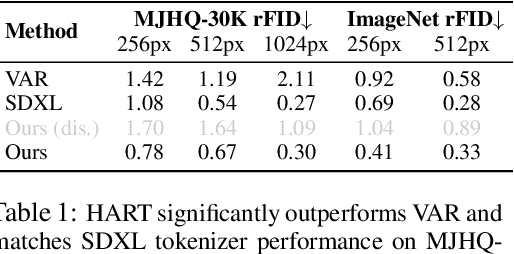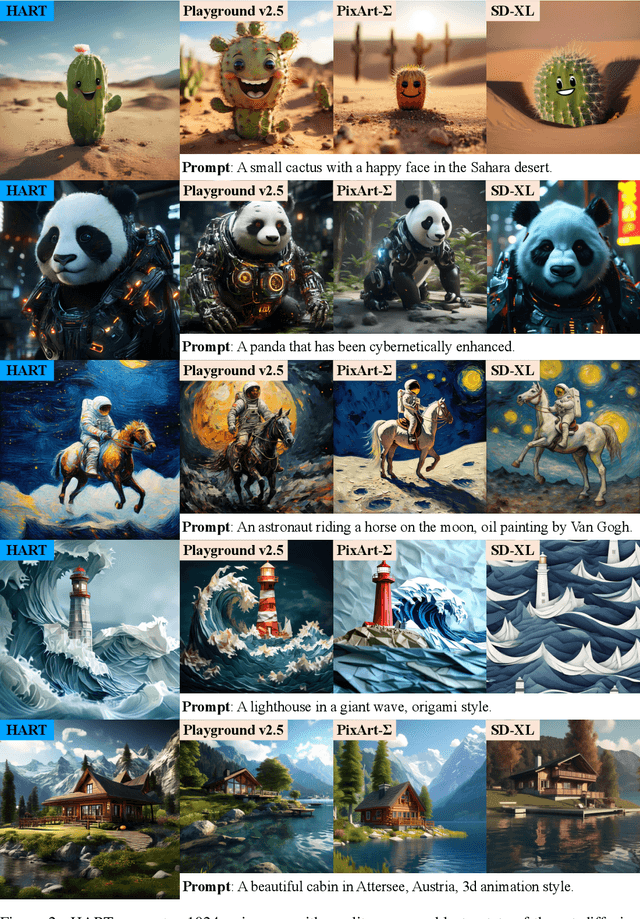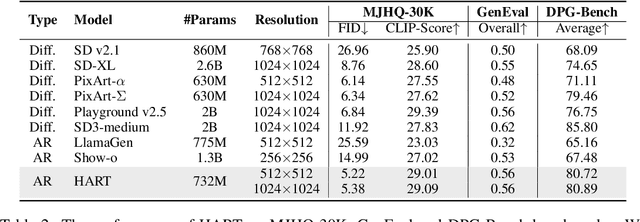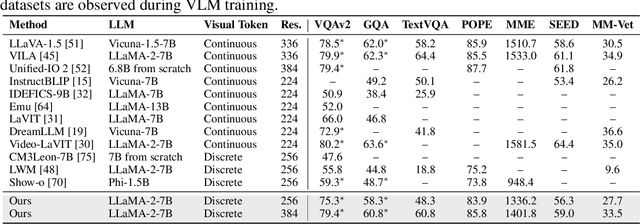Enze Xie
Fast-dLLM: Training-free Acceleration of Diffusion LLM by Enabling KV Cache and Parallel Decoding
May 28, 2025Abstract:Diffusion-based large language models (Diffusion LLMs) have shown promise for non-autoregressive text generation with parallel decoding capabilities. However, the practical inference speed of open-sourced Diffusion LLMs often lags behind autoregressive models due to the lack of Key-Value (KV) Cache and quality degradation when decoding multiple tokens simultaneously. To bridge this gap, we introduce a novel block-wise approximate KV Cache mechanism tailored for bidirectional diffusion models, enabling cache reuse with negligible performance drop. Additionally, we identify the root cause of generation quality degradation in parallel decoding as the disruption of token dependencies under the conditional independence assumption. To address this, we propose a confidence-aware parallel decoding strategy that selectively decodes tokens exceeding a confidence threshold, mitigating dependency violations and maintaining generation quality. Experimental results on LLaDA and Dream models across multiple LLM benchmarks demonstrate up to \textbf{27.6$\times$ throughput} improvement with minimal accuracy loss, closing the performance gap with autoregressive models and paving the way for practical deployment of Diffusion LLMs.
Magic 1-For-1: Generating One Minute Video Clips within One Minute
Feb 11, 2025Abstract:In this technical report, we present Magic 1-For-1 (Magic141), an efficient video generation model with optimized memory consumption and inference latency. The key idea is simple: factorize the text-to-video generation task into two separate easier tasks for diffusion step distillation, namely text-to-image generation and image-to-video generation. We verify that with the same optimization algorithm, the image-to-video task is indeed easier to converge over the text-to-video task. We also explore a bag of optimization tricks to reduce the computational cost of training the image-to-video (I2V) models from three aspects: 1) model convergence speedup by using a multi-modal prior condition injection; 2) inference latency speed up by applying an adversarial step distillation, and 3) inference memory cost optimization with parameter sparsification. With those techniques, we are able to generate 5-second video clips within 3 seconds. By applying a test time sliding window, we are able to generate a minute-long video within one minute with significantly improved visual quality and motion dynamics, spending less than 1 second for generating 1 second video clips on average. We conduct a series of preliminary explorations to find out the optimal tradeoff between computational cost and video quality during diffusion step distillation and hope this could be a good foundation model for open-source explorations. The code and the model weights are available at https://github.com/DA-Group-PKU/Magic-1-For-1.
SANA 1.5: Efficient Scaling of Training-Time and Inference-Time Compute in Linear Diffusion Transformer
Jan 30, 2025



Abstract:This paper presents SANA-1.5, a linear Diffusion Transformer for efficient scaling in text-to-image generation. Building upon SANA-1.0, we introduce three key innovations: (1) Efficient Training Scaling: A depth-growth paradigm that enables scaling from 1.6B to 4.8B parameters with significantly reduced computational resources, combined with a memory-efficient 8-bit optimizer. (2) Model Depth Pruning: A block importance analysis technique for efficient model compression to arbitrary sizes with minimal quality loss. (3) Inference-time Scaling: A repeated sampling strategy that trades computation for model capacity, enabling smaller models to match larger model quality at inference time. Through these strategies, SANA-1.5 achieves a text-image alignment score of 0.72 on GenEval, which can be further improved to 0.80 through inference scaling, establishing a new SoTA on GenEval benchmark. These innovations enable efficient model scaling across different compute budgets while maintaining high quality, making high-quality image generation more accessible.
Char-SAM: Turning Segment Anything Model into Scene Text Segmentation Annotator with Character-level Visual Prompts
Dec 27, 2024Abstract:The recent emergence of the Segment Anything Model (SAM) enables various domain-specific segmentation tasks to be tackled cost-effectively by using bounding boxes as prompts. However, in scene text segmentation, SAM can not achieve desirable performance. The word-level bounding box as prompts is too coarse for characters, while the character-level bounding box as prompts suffers from over-segmentation and under-segmentation issues. In this paper, we propose an automatic annotation pipeline named Char-SAM, that turns SAM into a low-cost segmentation annotator with a Character-level visual prompt. Specifically, leveraging some existing text detection datasets with word-level bounding box annotations, we first generate finer-grained character-level bounding box prompts using the Character Bounding-box Refinement CBR module. Next, we employ glyph information corresponding to text character categories as a new prompt in the Character Glyph Refinement (CGR) module to guide SAM in producing more accurate segmentation masks, addressing issues of over-segmentation and under-segmentation. These modules fully utilize the bbox-to-mask capability of SAM to generate high-quality text segmentation annotations automatically. Extensive experiments on TextSeg validate the effectiveness of Char-SAM. Its training-free nature also enables the generation of high-quality scene text segmentation datasets from real-world datasets like COCO-Text and MLT17.
SVDQuant: Absorbing Outliers by Low-Rank Components for 4-Bit Diffusion Models
Nov 07, 2024



Abstract:Diffusion models have been proven highly effective at generating high-quality images. However, as these models grow larger, they require significantly more memory and suffer from higher latency, posing substantial challenges for deployment. In this work, we aim to accelerate diffusion models by quantizing their weights and activations to 4 bits. At such an aggressive level, both weights and activations are highly sensitive, where conventional post-training quantization methods for large language models like smoothing become insufficient. To overcome this limitation, we propose SVDQuant, a new 4-bit quantization paradigm. Different from smoothing which redistributes outliers between weights and activations, our approach absorbs these outliers using a low-rank branch. We first consolidate the outliers by shifting them from activations to weights, then employ a high-precision low-rank branch to take in the weight outliers with Singular Value Decomposition (SVD). This process eases the quantization on both sides. However, na\"{\i}vely running the low-rank branch independently incurs significant overhead due to extra data movement of activations, negating the quantization speedup. To address this, we co-design an inference engine Nunchaku that fuses the kernels of the low-rank branch into those of the low-bit branch to cut off redundant memory access. It can also seamlessly support off-the-shelf low-rank adapters (LoRAs) without the need for re-quantization. Extensive experiments on SDXL, PixArt-$\Sigma$, and FLUX.1 validate the effectiveness of SVDQuant in preserving image quality. We reduce the memory usage for the 12B FLUX.1 models by 3.5$\times$, achieving 3.0$\times$ speedup over the 4-bit weight-only quantized baseline on the 16GB laptop 4090 GPU, paving the way for more interactive applications on PCs. Our quantization library and inference engine are open-sourced.
SANA: Efficient High-Resolution Image Synthesis with Linear Diffusion Transformers
Oct 15, 2024



Abstract:We introduce Sana, a text-to-image framework that can efficiently generate images up to 4096$\times$4096 resolution. Sana can synthesize high-resolution, high-quality images with strong text-image alignment at a remarkably fast speed, deployable on laptop GPU. Core designs include: (1) Deep compression autoencoder: unlike traditional AEs, which compress images only 8$\times$, we trained an AE that can compress images 32$\times$, effectively reducing the number of latent tokens. (2) Linear DiT: we replace all vanilla attention in DiT with linear attention, which is more efficient at high resolutions without sacrificing quality. (3) Decoder-only text encoder: we replaced T5 with modern decoder-only small LLM as the text encoder and designed complex human instruction with in-context learning to enhance the image-text alignment. (4) Efficient training and sampling: we propose Flow-DPM-Solver to reduce sampling steps, with efficient caption labeling and selection to accelerate convergence. As a result, Sana-0.6B is very competitive with modern giant diffusion model (e.g. Flux-12B), being 20 times smaller and 100+ times faster in measured throughput. Moreover, Sana-0.6B can be deployed on a 16GB laptop GPU, taking less than 1 second to generate a 1024$\times$1024 resolution image. Sana enables content creation at low cost. Code and model will be publicly released.
Deep Compression Autoencoder for Efficient High-Resolution Diffusion Models
Oct 14, 2024



Abstract:We present Deep Compression Autoencoder (DC-AE), a new family of autoencoder models for accelerating high-resolution diffusion models. Existing autoencoder models have demonstrated impressive results at a moderate spatial compression ratio (e.g., 8x), but fail to maintain satisfactory reconstruction accuracy for high spatial compression ratios (e.g., 64x). We address this challenge by introducing two key techniques: (1) Residual Autoencoding, where we design our models to learn residuals based on the space-to-channel transformed features to alleviate the optimization difficulty of high spatial-compression autoencoders; (2) Decoupled High-Resolution Adaptation, an efficient decoupled three-phases training strategy for mitigating the generalization penalty of high spatial-compression autoencoders. With these designs, we improve the autoencoder's spatial compression ratio up to 128 while maintaining the reconstruction quality. Applying our DC-AE to latent diffusion models, we achieve significant speedup without accuracy drop. For example, on ImageNet 512x512, our DC-AE provides 19.1x inference speedup and 17.9x training speedup on H100 GPU for UViT-H while achieving a better FID, compared with the widely used SD-VAE-f8 autoencoder. Our code is available at https://github.com/mit-han-lab/efficientvit.
HART: Efficient Visual Generation with Hybrid Autoregressive Transformer
Oct 14, 2024



Abstract:We introduce Hybrid Autoregressive Transformer (HART), an autoregressive (AR) visual generation model capable of directly generating 1024x1024 images, rivaling diffusion models in image generation quality. Existing AR models face limitations due to the poor image reconstruction quality of their discrete tokenizers and the prohibitive training costs associated with generating 1024px images. To address these challenges, we present the hybrid tokenizer, which decomposes the continuous latents from the autoencoder into two components: discrete tokens representing the big picture and continuous tokens representing the residual components that cannot be represented by the discrete tokens. The discrete component is modeled by a scalable-resolution discrete AR model, while the continuous component is learned with a lightweight residual diffusion module with only 37M parameters. Compared with the discrete-only VAR tokenizer, our hybrid approach improves reconstruction FID from 2.11 to 0.30 on MJHQ-30K, leading to a 31% generation FID improvement from 7.85 to 5.38. HART also outperforms state-of-the-art diffusion models in both FID and CLIP score, with 4.5-7.7x higher throughput and 6.9-13.4x lower MACs. Our code is open sourced at https://github.com/mit-han-lab/hart.
VILA-U: a Unified Foundation Model Integrating Visual Understanding and Generation
Sep 06, 2024



Abstract:VILA-U is a Unified foundation model that integrates Video, Image, Language understanding and generation. Traditional visual language models (VLMs) use separate modules for understanding and generating visual content, which can lead to misalignment and increased complexity. In contrast, VILA-U employs a single autoregressive next-token prediction framework for both tasks, eliminating the need for additional components like diffusion models. This approach not only simplifies the model but also achieves near state-of-the-art performance in visual language understanding and generation. The success of VILA-U is attributed to two main factors: the unified vision tower that aligns discrete visual tokens with textual inputs during pretraining, which enhances visual perception, and autoregressive image generation can achieve similar quality as diffusion models with high-quality dataset. This allows VILA-U to perform comparably to more complex models using a fully token-based autoregressive framework.
Segment, Lift and Fit: Automatic 3D Shape Labeling from 2D Prompts
Jul 16, 2024

Abstract:This paper proposes an algorithm for automatically labeling 3D objects from 2D point or box prompts, especially focusing on applications in autonomous driving. Unlike previous arts, our auto-labeler predicts 3D shapes instead of bounding boxes and does not require training on a specific dataset. We propose a Segment, Lift, and Fit (SLF) paradigm to achieve this goal. Firstly, we segment high-quality instance masks from the prompts using the Segment Anything Model (SAM) and transform the remaining problem into predicting 3D shapes from given 2D masks. Due to the ill-posed nature of this problem, it presents a significant challenge as multiple 3D shapes can project into an identical mask. To tackle this issue, we then lift 2D masks to 3D forms and employ gradient descent to adjust their poses and shapes until the projections fit the masks and the surfaces conform to surrounding LiDAR points. Notably, since we do not train on a specific dataset, the SLF auto-labeler does not overfit to biased annotation patterns in the training set as other methods do. Thus, the generalization ability across different datasets improves. Experimental results on the KITTI dataset demonstrate that the SLF auto-labeler produces high-quality bounding box annotations, achieving an AP@0.5 IoU of nearly 90\%. Detectors trained with the generated pseudo-labels perform nearly as well as those trained with actual ground-truth annotations. Furthermore, the SLF auto-labeler shows promising results in detailed shape predictions, providing a potential alternative for the occupancy annotation of dynamic objects.
 Add to Chrome
Add to Chrome Add to Firefox
Add to Firefox Add to Edge
Add to Edge